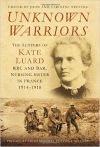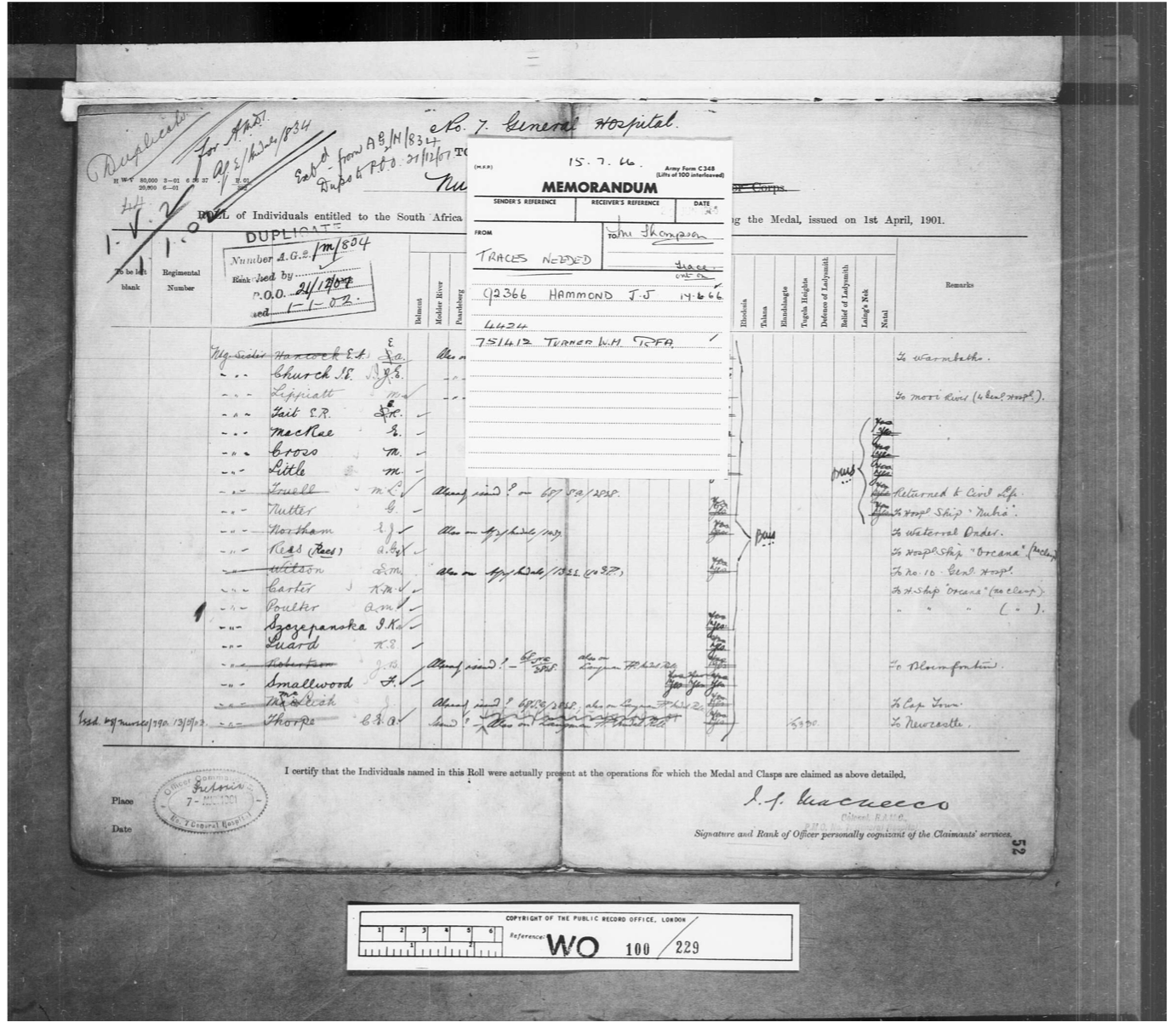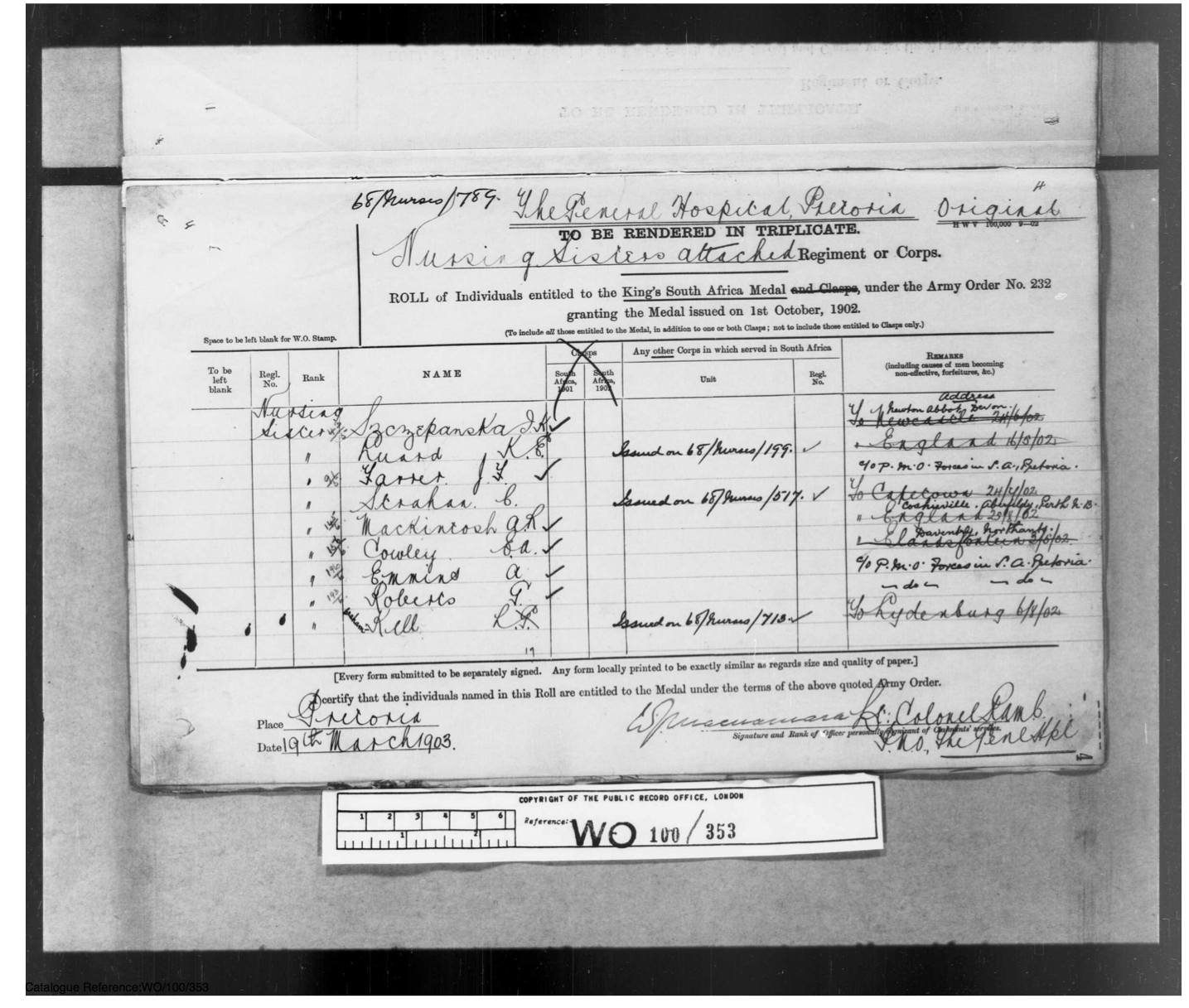Boer War Medal Rolls
Context
The Boer War (South Africa 1899-1901) was important for British military nursing as it was the first major conflict for Britain in which nurses in large numbers had been deployed, and at the end of the war a new nursing service was created, the Queen Alexandra’s Imperial Military Nursing Service (QAIMNS), which saw nurses becoming a formed component of the British Army. The war in 1899 was the second war to occur between the Boers and the British. The First Boer War occurred in 1881 and ended in a defeat of the British at Majuba Hill. The second conflict is often referred to as the Second South African War, the Second Anglo-Boer War, the Great Boer War, the War in South Africa and various other names. Modern histories frequently refer to it as the Anglo-Boer War, although traditionally the second conflict has become known as the Boer War[1] [2] [3] [4] [5]. In Afrikaans it is known as Tweede Vryheidsoorlog or Tweede Boereoorlog.
The Medal Rolls
The Queen’s South Africa Medal (QSA) was awarded for service in the Boer War. Twenty-six clasps were issued for wearing on the QSA although individuals were rarely awarded more than nine. Nurses were not entitled to clasps as they were classified as ‘non-combatant’. The QSA was awarded to individuals who served from 11th October, 1899 to 31st May, 1902. Following Queen Victoria’s death, King Edward VII authorised the King’s South Africa Medal (KSA) to be awarded to all who were serving in South Africa on or after the 1st January, 1902, and who had completed 18 months service before the 1st June, 1902.
The medal was never issued alone but always with the QSA. Confirming the eligibility for these awards was the responsibility of individual units who recorded the details of serving personnel on a medal sheet, which was then forwarded to the War Office. Individual nurses might appear on more than one medal sheet, as each unit they served with might record them. The War Office collated these sheets into medal rolls. These medal rolls form the definitive list of nurses serving in the Boer War. They record nurses serving in the Army Nursing Service (ANS); the Princess Christian's Army Nursing Service (Reserve) (PCANSR); Australian, Canadian and New Zealand Nurses; civilian nurses and nurses locally engaged (all of whom are likely to have had training as a nurse). They also include religious Sisters (who may or may not have been nurses, but were involved in giving nursing care) and some civilians who are not likely to have been nurses, but were engaged in the delivery or support of nursing care.
These medal rolls are now part of The National Archives, Kew. They can be feely downloaded in pdf form from their website. There are several rolls that contain details of nurses, for example, WO 100/130 contains details from the Imperial Yeomanry Hospitals. WO 100/225 contains details of nurses from the Red Cross Hospitals (These hospitals all came under the control of the Army before the end of the Boer War). WO 100/229 contains the vast majority of nurses and covers all military hospitals.
The complete list of medal rolls for nurses awarded the QSA (and thus serving during the Boer War) is:
- WO 100/130 Medal Roll for the Imperial Yeomanry
- WO 100/222 Medal Roll for the General Hospitals
- WO 100/223 Medal Roll for the Stationery Hospitals and Bearer Companies
- WO 100/225 Medal Roll for the Red Cross Contingent and Private Hospitals
- WO 100/229 Medal Roll for Nurses
- WO 100/287 Medal Roll for the Canadian Contingents
- WO 100/288 Medal Roll for the New South Wales Contingent (Part 1)
- WO 100/289 Medal Roll for the New South Wales Contingent (Part 2)
- WO 100/290 Medal Roll for the Victoria Contingent
- WO 100/292 Medal Roll for the South and West Australia Contingents
- WO 100/293 Medal Roll for the Australian Medical Corps and Tasmanian Contingents
- WO 100/294 Medal Roll for the New Zealand Contingent (Part 1)
- WO 100/295 Medal Roll for the New Zealand Contingent (Part 2)
- WO 100/371 Medal Roll for the Burgher Camps
- The KSA Medal Rolls are all together in WO 353
Sister Kate Luard
Sister Kate Luard has become well known because her family has published the letters she wrote during World War 1. This book Unknown Warriors has been updated and re-released. What many do not know, however, that she was an Army nurse during the Boer War, and so was one of the many Boer War nursing 'veterans' who helped to shape nursing in WW1. She also wrote many letters during the Boer War too, although these have not been published. They are available to view in the Essex County Archives.
We know from the medal rolls that Sister Kate Luard served in South Africa with No. 7 General Hospital at Escort and Pretoria.
The two relevant pages are here below.
There is a date on this document - August 7th 1901. This does not relate to the service of any of the nurses named, but is the date on which the document was signed off by the Commanding Officer. The nurses listed could have been present at that time, or as indicated in the notes, may already have left the hospital.
You can also see that the medal rolls were marked and scored out by those back at the War Office responsible for sending out the medals. This frequently obscures details for those, like us, trying to read them many years later. This particular page also has a note stuck on it which obscures some of the title information. To determine if these nursing sisters were Army Nursing Service or Reservists we would need corroboration from other sources.
When looking through medal rolls do not be confused between pages in the pdf document and the page numbers allocated to each page of the medal roll. This page is actually page 54 of the document I downloaded, but you can clearly see the page number 52 in the bottom left corner. It is this number that forms part of the reference for this page.
You can see that by 1903 when this medal roll was completed the hospital designation had changed to 'The General Hospital, Pretoria'. This medal roll also does not state whether the nurses are Army Nursing Service or Reservists. The entry for Sister Kate Luard is annotated 'to England 16/5/02', so that helps to establish her return from South Africa, and as before we could then seek corroboration of this in either the shipping lists, or in the nursing journals of that date.
Although these medal rolls do not contain much information, they are one of few official sources, and the most definitive for establishing a nurse's involvement in the Boer War.
The list of nurses that was created as part of my research is still available at | http://baseportal.com/cgi-bin/baseportal.pl?htx=/pcansr/Research/research.
References
- ↑ Conan Doyle, A (1900) The Great Boer War. London: Smith, Elder & Co.
- ↑ Pakenham, T. (1979) The Boer War. Random House, New York.
- ↑ Carver, M. (2000) The National Army Museum Book of the Boer War. London: Pan
- ↑ Fremont-Barnes, G. (2003) The Boer War 1899-1902. Osprey: London.
- ↑ Low-Beer, D., Smallman-Raynor, M., & Cliff A. (2004) Disease and death in the South African War. <>b>Social History of Medicine. 17 (2): pp. 223-245



